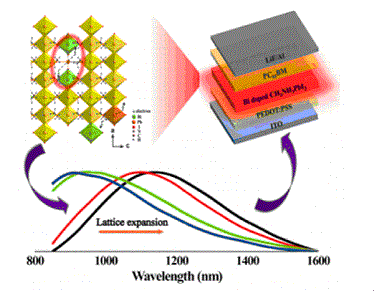†, †, †, †, †, ‡, ‡, †, †(孙洪涛), and †(宋波)
† College of Chemistry, Chemical Engineering and Materials Science, Soochow University, Suzhou 215123, China
‡ School of Materials Science and Engineering, Shanghai Institute of Technology, Shanghai 201418, China
J. Phys. Chem. Lett., 2016, 7 (14), pp 2735–2741
Doping of semiconductors by introducing foreign atoms enables their widespread applications in microelectronics and optoelectronics. We show that this strategy can be applied to direct bandgap lead-halide perovskites, leading to the realization of ultrawide photoluminescence (PL) at new wavelengths enabled by doping bismuth (Bi) into lead-halide perovskites. Structural and photophysical characterization reveals that the PL stems from one class of Bi doping-induced optically active center, which is attributed to distorted [PbI6] units coupled with spatially localized bipolarons. Additionally, we find that compositional engineering of these semiconductors can be employed as an additional way to rationally tune the PL properties of doped perovskites. Finally, we accomplished the electroluminescence at cryogenic temperatures by using this system as an emissive layer, marking the first electrically driven devices using Bi-doped photonic materials. Our results suggest that low-cost, earth-abundant, solution-processable Bi-doped perovskite semiconductors could be promising candidate materials for developing optical sources operating at new wavelengths.

链接:http://pubs.acs.org/doi/abs/10.1021/acs.jpclett.6b01147